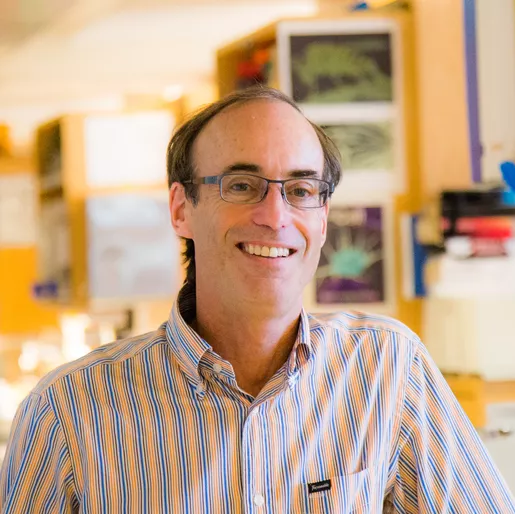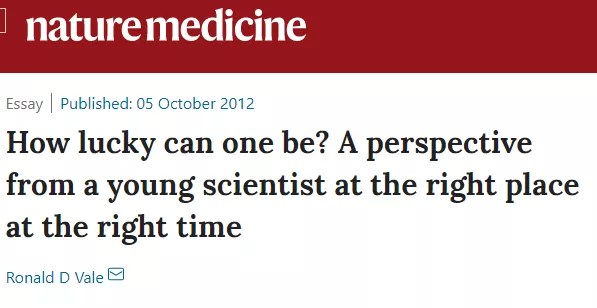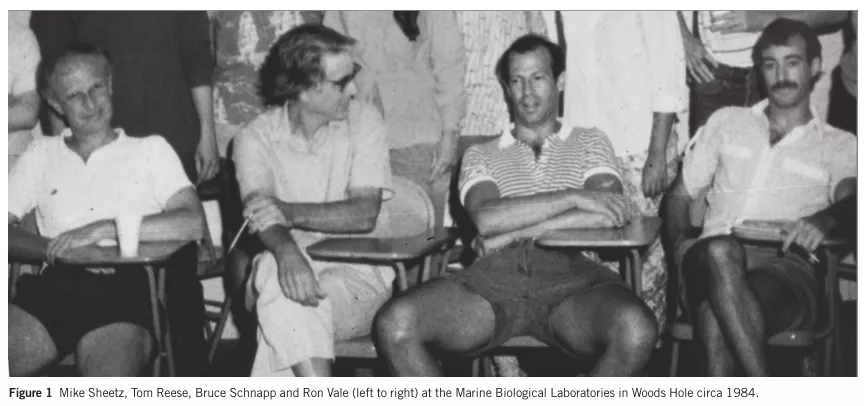“他創(chuàng)造了世界記錄:一年內(nèi)作為第一作者發(fā)4篇Cell論文,迄今無人能夠打破。”
“他研究生期間共發(fā)表12篇第一作者的實驗論文,相當(dāng)于一般好幾個研究生。”
“他的論文解決了一個重要問題,將研究推到新層次。”
首都醫(yī)科大學(xué)校長饒毅曾如此評價Ron Vale。因為Ron Vale在研究生時期和其導(dǎo)師 Mike Sheetz、Jim Spudich等在闡明生命分子運動機制方面的做出的奠定性貢獻,他們也因此一起成為諾貝爾獎的熱門候選人。2012年 ,三人共同獲得了拉斯克基礎(chǔ)醫(yī)學(xué)研究獎。獲獎后,在獲獎感言中,Ron Vale總結(jié)了他認(rèn)為非常重要的博士研究生做科研的“TOP-Ten lessons ”發(fā)表在了Nature Medicine (IF=36)雜志上,分享給大家。

/ Ronald D Vale/
PhD,UCSF Professor,HHMI Investigator
Ronald D Vale教授 1959 年出生在美國加州好萊塢。21 歲畢業(yè)于加州大學(xué)圣塔芭芭拉分校,專業(yè)生物和化學(xué)。之后在斯坦福大學(xué)念雙博士(哲學(xué)博士-醫(yī)學(xué)博士),在26 歲獲神經(jīng)生物學(xué)哲學(xué)博士。因為他的研究生記錄太好,他就只要哲學(xué)博士,不要醫(yī)學(xué)博士。 27 歲成為助理教授,35 歲做正教授,42 歲當(dāng)選美國科學(xué)院院士。美國藝術(shù)與科學(xué)學(xué)院院士以及美國國家科學(xué)院院士雙料院士。自 1995 年以來,一直擔(dān)任霍華德·休斯醫(yī)學(xué)研究所研究員。也是諾貝爾獎熱門人選。
1985 年,在Sheetz和Reese實驗室,年僅26 歲的Ron Vale,一年內(nèi)發(fā)表了 5 篇 Cell ,其中 4 篇是第一作者,記錄保持至今,未被打破。
2006年,Ron Vale 教授創(chuàng)建了影響巨大的生物醫(yī)學(xué)學(xué)術(shù)視頻網(wǎng)站iBiology。2011年,iBiology合作網(wǎng)站-iBioChina開通,Ron Vale教授專門錄制了演講視頻表示祝賀。在視頻中,他特意選用了中國的平遙古城作為背景,表達了自己因事未能出席開通儀式的遺憾。
2012年 ,他和邁克爾·希茨和詹姆斯·斯普迪赫共同獲拉斯克基礎(chǔ)醫(yī)學(xué)研究獎。獲獎后,更是把他的獲獎感言:自己的求學(xué)經(jīng)歷和總結(jié)的十條科研經(jīng)驗(top-ten list )發(fā)表在了Nature Medicine 雜志上,題為:How lucky can one be? A perspective from a young scientist at the right place at the right time,以下為文中 Ten lessons 中文譯文及英文原文,分享給大家。

以下是我從之前的經(jīng)歷中學(xué)到的最重要的10件事,其中大部分是事后才發(fā)現(xiàn)的。我沉醉在科學(xué)中,經(jīng)常犯錯誤,也常常從錯誤中吸取教訓(xùn),但我?guī)缀醪恢肋@會把我?guī)蚝畏剑膊恢牢易罱K會以什么方式出現(xiàn)。我不知道科學(xué)將把我?guī)蚝翁帲矝]想過最終能取得什么成就。
Here is my top-ten list of what I learned from this experience, most which only became obvi-ous in retrospect. I was immersed in the sci-ence, making and sometimes learning from mistakes and having very little idea of where it would all lead and how or where I would emerge at the end.
——Ron Vale

TOP-Ten lessons
01 找到好導(dǎo)師,學(xué)習(xí)他們?nèi)缓蟀l(fā)展出自己的風(fēng)格
Find good mentors,
learn from them and then develop your own style.
三人行,必有我?guī)煛?茖W(xué)既是一個實驗過程,也是一個處理問題的哲學(xué)、個人研究風(fēng)格和與他人合作本身就是一個實驗的過程。作為一名年輕的科學(xué)家,你要接觸不同的科研方法,從資深的前輩科學(xué)家那里汲取思想和治學(xué)態(tài)度,加以消化吸收,最終沉淀出最適合自己的一種風(fēng)格,這會讓你具有你所欽佩的人的氣質(zhì)特征。對他人不卑不亢,既不盲目崇拜也不輕蔑輕視。我很幸運,遇到了很多偉大的導(dǎo)師,其中包括Bruce Schnapp, Tom Reese, Mike Sheetz和Jim Spudich的核心團體。他們每個人都有獨特的個性和科研方法,這讓我受益匪淺。但他們有一個共同點:都非常友善,把我當(dāng)做一個年輕的科學(xué)家來支持。我研究生時還遇到其他的貴人:首先是我的導(dǎo)師Eric Shooter。想想,有幾位論文導(dǎo)師能由著他的研究生游離在導(dǎo)師的課題之外,做一些與實驗室工作無關(guān)的事?而且任由其對學(xué)分一點都不上心?那個時候,我還沒有完全意識到,和其他許多科學(xué)家相比,Eric對他的實驗室“家庭”是多么的無私。在MBL,我還遇到了Shinya Inoue和Andrew Szent-Gyorgyi等活躍的老科學(xué)家。他們在Woods Hole的冬季收留了我這個從西海岸來的孩子,他們的實驗室小而專一(不同于斯坦福的大型實驗室),他們熱愛生活,熱愛科研,實現(xiàn)生活和科研的完美統(tǒng)一,不偏廢其一。

Soak up your surroundings. Science is as much about philosophies of approaching problems, personal styles of research and working with others as the process of experimentation itself. As a young scientist, you need to be exposed to different ways of doing science, absorbing the ideas and attitudes of more senior scientists.The net result is a maturation of a hybrid style that best suits you and is a composite of the characteristics that you admire in different individuals. Neither idolize nor ignore anyone. I was fortunate to have many great mentors, which included the core group of Bruce Schnapp, Tom Reese, Mike Sheetz and Jim Spudich. I gained tremendously from their unique personalities and scientific approaches. But they all shared one thing in common—they were incredibly kind and supportive of me as a young scientist. I had additional heroes in graduate school. First was my wonderful advisor, Eric Shooter. How many thesis advisors would let their graduate student wander off quite a distance to work on a project unrelated to his or her own lab's work and without any thought of gaining credit for something that might emerge? I did not completely appreci-ate at the time how different Eric s unselfishattitude about his lab family is from that ofmany scientists. I also met lively older scien-tists at the MBL-Shinya Inoue and Andrew Szent-Gyorgyi who adopted this kid from the West Coast during the Woods Hole winter.They had small and focused labs (unlike the generally larger labs at Stanford) and merged alove of life and a love of science without com-promising either.
02 選擇一個重要的問題
Pick an important problem.
每個人都一樣,都喜歡去解決有趣的,令人著迷的問題,而不喜歡沉悶無聊的問題。但是,確定一個既重要又亟需解決的選題并非易事。況且,我們還必須在規(guī)定的時間節(jié)點內(nèi)完成對應(yīng)的結(jié)果,才能獲得學(xué)位、工作或者資助。這使得我們中的大部分人在大多數(shù)時間里,精力并不是專注于生物學(xué)中的大問題上。但是,如果你想不一樣,在一些重要問題上,你必須實時跟進,時刻保持警惕,比別人多思考一點,哪怕超出了你的研究范圍或你的專長,從而找到一個重大問題的突破口。如果機會來了(見下一建議),千萬別錯過,抓住它。在大多數(shù)情況下,如果你一時候沒能提出一個重要的問題,你基本不可能做出重大成果。
Everyone would rather solve a fascinating problem than a boring one. However, it is not easy to identify a project that is both important and ripe forsolving. Furthermore, pragmatics dictate get-ting results in a defined time period in order to obtain a degree, job or grant. As a result, most of us are not always working on grand issues in biology all of the time, However, you should be vigilant and thoughtful, loking for a wedge or an opening to tackle an important problem, even if it is not in your area of research or expertise. If the opportunity comes along (see next point), seize it. In most cases, you cannot make an important discovery if you are not asking an important question from the start.
3 奮力領(lǐng)先,勇于冒險,敢于放手一搏
Get ahead but then take a chance: seek adventure
在Eric Shooter實驗室的頭兩三年里,我發(fā)表了幾篇很扎實但并不出色的論文,但我知道,這些論文已足以讓我拿到博士學(xué)位。有了這個安全保障,我就有可以自由的去尋找并拿下一個重大但有風(fēng)險的項目了。隨著對Sheetz/Spudich試驗不斷的接觸,我的機會來了。從我最后一刻決定去Woods Hole開始,軸突運輸項目對我來說整個就是一場冒險。當(dāng)把科學(xué)當(dāng)做一場偉大的冒險,整個事情就變得有趣了,無論是你的科學(xué)成果還是你的個人事業(yè),會有很多意想不到的事情發(fā)生。
In my first two to three years in Eric Shooter s lab, I published a couple of papers that were solid but not outstanding, but I knew that they were sufficient to get a PhD.With that safety net, I had the freedom to lookfor and take on an important but risky project.That opportunity came along with the chance to build upon the Sheetz/Spudich experiment.The whole axonal transport project was an adventure, beginning with a relatively last minute decision to go to Woods Hole. Thinking of science as a grand adventure makes it fun and allows unexpected things to happen, interms of both scientific outcomes and your personal career,
4 讀文獻很重要,但不要讓它成為你的束縛
Read the literature but don't be crippled by it
進入一個新領(lǐng)域,因為其悠久的歷史和大量的研究文獻,難免會讓人顯得底氣不足,畏手畏腳。這時你必須對先前的工作有一定的了解,但一定要避免陷于各種各樣先前試驗,掉入按照既有模型進行思考的陷阱。新鮮的視角,和一點很傻很天真的童心會很有用。我剛接觸這個領(lǐng)域時,當(dāng)時軸突的快速運輸文獻已經(jīng)很多,但其機理尚不清楚。然而,Allen,Brady和Lasek視頻顯微鏡研究成了關(guān)鍵的轉(zhuǎn)折點,因為它們提供了一種成像小運動囊泡的新方法。未來,通過生物化學(xué)來建立這種方法變得可行了,而在此之前,藥理學(xué)主導(dǎo)了整個工作。
It can be daunting to enter a new field because of its considerable history and litera-ture. You have to be knowledgeable about prior work, but it is also good to avoid getting caught in the trap of doing variations of prior experi-ments and thinking along the lines of existing models. Fresh eyes and some na?veté can be a good thing. Fast axonal transport at the time had a long literature but relatively little clar-ity on the mechanism. The Allen, Brady and Lasek video microscopy studies, however, were a turning point because they provided a new way to image small moving vesicles . Going forward, it made sense to build upon that method by doing biochemistry and not stick-ing to pharmacology, which had dominated work in the past.
5 出好成果不一定要有頂級實驗室
You don't need a fancy lab to do good science
我的實驗室在斯坦福大學(xué)的一個相對較新的大樓中,它有些陳舊卻井然有序。而位于海洋生物實驗室中的Tom Reese的研究室則相對較亂,在Loeb大樓的地下室的一個小房間中,只有一臺化學(xué)試劑單放機和一些鋪滿設(shè)備間的小設(shè)備。我們在被海水熏的潮濕的地下室房間中解剖烏賊巨軸突。我們戲稱這個小房間為“海王星的洞穴”。但是這一切都沒有產(chǎn)生負(fù)面影響,相反,與那些在現(xiàn)代大樓中流行的井然有序卻單調(diào)的實驗室相比,這個實驗室讓人耳目一新。Tom的實驗室有符合目前水平滿足基本工作需要的設(shè)備-------視頻燈和電子顯微鏡。但是在對驅(qū)動蛋白提純的初始階段,我們樓里沒有離心機,所以我們不得不到馬路對面的樓中去進行這一步,那時也沒有色譜分析設(shè)備。但是,一個人可以適應(yīng)任何環(huán)境然后使其正常運轉(zhuǎn)。這也是科學(xué)探險一部分。
I came from a pristine, well-organized laboratory in a relatively new building at Stanford. Tom Reese's lab at the Marine Biology Laboratory, in contrast, was a chaotic rabbit warren of small rooms in the basement of the Loeb building, with a monolayer of chemical reagents and small equipment covering most of the available bench space. We dissected squid giant axons in a wet and dank seawater room in the basement, which we called 'Neptune's cave‘。 But none of this mattered, and it was a refreshing change from the well-organized rows of monotonous lab benches that popu-late most modern research buildings. Tom's lab had state-of-the-art equipment that proved essential for the work—video light and electron microscopy. But at the start of the kinesin puri-fication, there was no centrifuge in the building(we had to go to a building across the street)and no chromatography equipment (we ini-tially used syringes with glass wool)。 One can adapt to any surroundings and make things work. This also adds to the scientific adventure.
6 玩命工作,盡情玩耍
Work hard, play hard and squeeze in time to do your laundry.
科學(xué)不是朝九晚五的工作。在Wood Hole時,我工作異常努力。1984年的整個冬季,我?guī)缀醵荚诠ぷ鳎╓oods Hole的冬天本來也沒啥可干,所以我也沒有多大損失)。攻堅時刻需要加倍的努力,我很高興,在關(guān)鍵時刻我花了盡可能多的時間在實驗室,見證了科學(xué)奇跡的發(fā)生。但是,在接下來的春天,我需要離開一段時間來調(diào)整狀態(tài),所以我騎車游行了歐洲。在到UCSF工作前,我還在尼泊爾和日本玩了四個月。科研關(guān)鍵時刻的攻堅十分重要,就如同打仗時攻克關(guān)鍵要塞。但與此同時,你也必須花時間來平衡你的生活。
Science is not a9-to-5 job. I worked very hard on the projects at Woods Hole; during the winter of 1984, I pretty much only worked (there was not a lot to do during the winter at Woods Hole, so I was not missing much)。 Special times require special effort, and I was incredibly happy spending as much time as I could in the lab and seeing the science come together. But later in the fol-lowing spring, I needed time off and went on a long bike trip in Europe. I also spent four months in Nepal and Japan before starting my job at UCSF. It is crucial to push a project hard at some points, but you also must make time to balance your life.
7 堅持比才華更重要
Persistence is more important than brilliance
如果你不是天生聰慧(就像我),只要你能堅持,一樣可以在實驗科學(xué)中做的很好。反過來就很難說。舉個例子,在1984年夏天的大部分時間里,因為一系列的實驗失誤,我未能在體外重建軸突運輸。眼看夏天就要結(jié)束,我馬上就要離開,開始我的見習(xí)醫(yī)生生涯。關(guān)鍵時刻,實驗卻毫無進展,或許這時,該去休息,去海邊的沙灘放松放松。但我并沒有這樣做,這也許是我在kinesin的故事中,唯一值得贊揚的地方。在我回到斯坦福之前,我近乎執(zhí)拗的堅持完成這個實驗。接著,在度過了神奇的一周后,一個見證奇跡的夜晚降臨,一切都是那么的順理成章。于是,我取消了我的返程航班。
If you are not naturally brilliant (my case), you can still do well in experimental science if you are persistent. The converse is harder. As an example, for much of the summer of 1984, I failed to reconstitute axonal transport in vitro, mostly owing to a series of experimental mistakes. The summer was drawing to a close and I was soon off to start my medical clerkships. With no success up until that point,it might have been a juncture at which to relax and spend time at the beach. Perhaps the only point to my credit in the kinesin story is that I did not take this path. I was dogmatic about giving this experiment my best shot before returning to Stanford. Then, one magical night followed by one magical week, everything came together. I cancelled my return flight.
8 誰都會犯錯
No project or career is immune from mistakes
盡管1983 - 1985年期間取得了成功,但它在科學(xué)上并不像看上去的那么完美。我們犯了一些概念上的錯誤和技術(shù)上的錯誤。幸運的是,這些錯誤并不致命,沒有讓我們偏離正確的軌道太遠(yuǎn)以致脫軌。這或許對那些課題不是一帆風(fēng)順的同學(xué)是一個安慰;時時的困惑,懷疑,對任何課題來說,都再正常不過了。同時,你也會錯過很多機會。那時,我們指出“溶液中的微管之間也相互作用,形成一個收縮的微管聚合門”8(現(xiàn)代術(shù)語:一個'aster’)這個論點,但是我們并沒有就此研究下去。運動蛋白對微管的自組織作用后來成為一個重要的研究領(lǐng)域。在美國國立研究院對我的第一次資助中,我還想以“存儲”逆行軸突運輸?shù)募兓ㄏ袷且环N叫做HMW 1的atp酶),作為我獲得NIH資助的第一個項目,事實證明這并不是一個明智的決定。職業(yè)生涯的每一步都不可避免的混雜著不良決策和英明決策,你只要保持后者比前者多就行了。
As successful as the 1983–1985period was, it was not as scientifically perfect as it may appear. We took some conceptual wrong turns and made technical mistakes. We were fortunate that they did not derail us too far off the track. Perhaps this will be comforting to stu-dents whose projects may not be going forward in a straight line; moments of confusion and doubt are typical for any project. There were also plenty of missed opportunities. We noted that “microtubules in solution also moved rela-tive to one another to form a contracted aggre-gate of microtubule” 8 (in modern terms, an'aster‘) but did not pursue it. Self-organization of microtubules by motor proteins later became an important area of research. I also thought to 'save' the purification of the retrograde axonal motor (most likely the ATPase called HMW 1 ) 8,9 for an aim in my first NIH grant,which turned out not to be a sensible decision,as I was scooped before I had the chance to do it. Every career is marked by poor and by good decisions; you just have to try to keep the score-card favoring the latter category.
9 莫對改變?nèi)松媱澑械交炭?/span>
Don't be afraid to change your life plans.
我二十歲和三十多歲早期時的人生是被規(guī)劃好的。MD-PhD項目后,最大可能是去醫(yī)院實習(xí),然后跟大部分人一樣成為一名住院醫(yī)師,然后再回到科學(xué)領(lǐng)域。然而,Woods Hole的出現(xiàn)改變了我的人生規(guī)劃。回到醫(yī)學(xué)院?從我現(xiàn)在的觀點來看,答案當(dāng)然是否定的。但是那時,其他人會怎么說呢?我的導(dǎo)師鼓勵我繼續(xù)堅持自己的課題并延遲醫(yī)學(xué)實習(xí);很顯然,我的心思一直在科學(xué)上,科學(xué)生涯將使我感到快樂。許多年后,單核馬達對醫(yī)學(xué)產(chǎn)生了影響使我感到極其滿意,同時,針對這種蛋白的藥物也正在研發(fā)中也是我倍感欣慰。
My twenties and early thirties could have been on autopilot—an MD-PhD program most likely followed by an internship and residency and a later return to science. However, the in vitro motility assays from Woods Hole threw a wrench into that plan. Return to medical school? Certainly not now from my point of view, but what would others say? My mentors encouraged me to stick with the project and defer my clerkships; Stanford Medical School was incredibly supportive, as well. I never returned to medicine; it became abundantly apparent that my heart was in science and that a scientific career would keep me happy. Many years later, it is gratifying to me that molecular motors are having an impact on medicine and that drugs are being developed that target these proteins.
10 科學(xué)發(fā)展太快:要堅持做時代的弄潮兒
Science is moving fast: hold on and enjoy the ride.
作為研究發(fā)現(xiàn)的親歷者是非常棒的感覺。但更大的樂趣是,你正在科學(xué)的大舞臺上,親眼目睹著科學(xué)作為一個整體所取得的驚人進步。科學(xué)家是非常幸運的,因為我們能站在世界的前沿,是巨大進步的見證者。科學(xué)冒險有許多形式,在實驗室的任何一天都有可能“擁抱”微小卻美妙的發(fā)現(xiàn)。在未來的某一天,某個巨大的驚喜最終到來。永遠(yuǎn)相信美好的事情即將發(fā)生。
It is nice to make your own discovery. But there is also great pleasure in having a seat in the big scientific arena and watching the amazing progress that is taking place overall. As an illustration, I was capti-vated by watching kinesin move vesicles or plastic beads, but it seemed hard to imagine in1984 how one would be able to understand the detailed inner workings of a motor so small. At that time, I could not envision the many new tools that would come along (single-molecule techniques, better structural methods, genomic studies of a multitude of kinesins) and the ideas contributed by the many people who would enter the field. In the subsequent two decades,we know of many kinesins and the many roles they play and have reasonable ideas of how they produce motion. This incredible progress is being played out in all areas of the life sci-ences, and we scientists are fortunate to have a front-row seat and witness the tremendous advances that are taking place.
附:
1985年他在Sheetz和Reese實驗室發(fā)表的五篇《Cell》,其中 4 篇他是第一作者:
[1] Vale, R.D., Schnapp, B.J., Sheetz, M.P. and Reese, T.S. (1985) Movement of organelles along filaments dissociated from the axoplasm of the squid giant axon. Cell 40: 449-454.
[2] Schnapp, B.J., Vale, R.D., Sheetz, M.P. and Reese, T.S. (1985) Single microtubules from squid axoplasm support bidirectional movement of organelles. Cell 40: 455-462.
[3] Vale, R.D., Schnapp, B.J., Reese, T.S. and Sheetz, M.P. (1985) Organelle, bead and microtubule translocations promoted by soluble factors form the squid giant axon. Cell 40: 559-569.
[4] Vale, R.D., Reese, T.S. and Sheetz, M.P. (1985) Identification of a novel force generating protein, kinesin, involved in microtubule-based motility. Cell 42: 39-50.
[5] Vale, R.D., Schnapp, B.J., Mitchison, T., Steuer, E., Reese, T.S. and Sheetz, M.P. (1985) Different axoplasmic proteins generate movement in opposite directions along microtubules in vitro. Cell 43: 623-632.
研究生期間,在斯坦福大學(xué) Eric Shooter 實驗室的另外 8 篇第一作者研究論文:
[1] Vale, R.D., DeLean, A., Lefkowitz, R.J. and Stadel, J.M. (1982) Regulation of insulin receptors in frog erythrocytes by insulin and concanavalin A: evidence for discrete classes of insulin binding sites. Mol. Pharm. 22: 6 19-629.
[2] Vale, R.D. and Shooter, E.M. (1983) Conversion of nerve growth factor receptor complexes to a slowly dissociating, Triton X-100 insoluble state by anti-nerve growth factor antibodies. Biochem. 22: 5022-5028.
[3] Vale, R.D. and Shooter, E.M. (1983) Epidermal growth factor receptors on PC12 cells: alteration of binding properties by lectins. J. Cell. Biochem. 22: 99-109.
[4] Vale, R.D., Peterson, S.W., Matiuck, N.V. and Fox, C.F. (1984) Purified plasma membranes inhibit polypeptide-induced DNA synthesis in subconfluent 3T3 cells. J. Cell Biol.
[5] Vale, R.D., Szent-Gy?rygi, A. and Sheetz, M.P. (1984) Movement of scallop myosin on Nitella actin filaments: regulation by calcium. Proc. Natl. Acad. Sci. USA
[6] Vale, R.D., Hosang, M. and Shooter, E.M. (1985)。 Sialic acid residues on NGF receptors on PC12 cells. Dev. Neurosci.
[7] Vale, R.D., Ignatius, M.J. and Shooter, E.M. (1985) Association of nerve growth factor receptors with the Triton X-100 cytoskeleton of PC12 cells. J. Neurosci. 5: 2762-2770.
1996年,他與 Fletterick 合作,首次解析了 kinesin 的結(jié)構(gòu):
Kull, F.J., Sablin, P., Lau, R., Fletterick, R.J. and Vale, R.D. (1996) Crystal structure of the kinesin motor domain reveals a structural similarity to myosin. Nature 380: 550-555.
1996年,已經(jīng)是正教授的他,自己做實驗首先直接看到 kinesin 單分子運動:
Vale, R.D., Funatsu, T., Pierce, D.W., Romberg, L., Harada, Y. and Yanagida, T. (1996) Direct observation of single kinesin molecules moving along microtubules by fluorescence microscopy. Nature 380: 451-453.
參考文獻:https://www.nature.com/articles/nm.2925
免責(zé)聲明:本網(wǎng)站所轉(zhuǎn)載的文字、圖片與視頻資料版權(quán)歸原創(chuàng)作者所有,如果涉及侵權(quán),請第一時間聯(lián)系本網(wǎng)刪除。

官方微信
《中國腐蝕與防護網(wǎng)電子期刊》征訂啟事
- 投稿聯(lián)系:編輯部
- 電話:010-62316606-806
- 郵箱:fsfhzy666@163.com
- 中國腐蝕與防護網(wǎng)官方QQ群:140808414





